Related Research Articles

The University of Cambridge is composed of 31 colleges in addition to the academic departments and administration of the central university. Until the mid-19th century, both Cambridge and Oxford comprised a group of colleges with a small central university administration, rather than universities in the common sense. Cambridge's colleges are communities of students, academics and staff – an environment in which generations and academic disciplines are able to mix, with both students and fellows experiencing "the breadth and excellence of a top University at an intimate level".

David Garrick was an English actor, playwright, theatre manager and producer who influenced nearly all aspects of European theatrical practice throughout the 18th century, and was a pupil and friend of Samuel Johnson. He appeared in several amateur theatricals, and with his appearance in the title role of Shakespeare's Richard III, audiences and managers began to take notice.

Clare Hall is a constituent college of the University of Cambridge, England. Founded in 1966 by Clare College, Clare Hall is a college for advanced study, admitting only postgraduate students alongside postdoctoral researchers and fellows. It was established to serve as an Institute of Advanced Studies and has slowly grown and developed into a full constituent college.
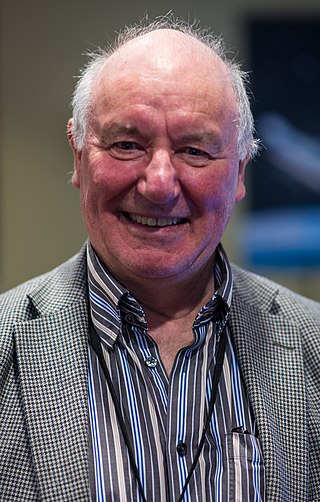
Malcolm Sim Longair is a British physicist. From 1991 to 2008 he was the Jacksonian Professor of Natural Philosophy in the Cavendish Laboratory at the University of Cambridge. Since 2016 he has been Editor-in-Chief of the Biographical Memoirs of Fellows of the Royal Society.

A windcatcher, wind tower, or wind scoop is a traditional architectural element, originated in Iran (Persia), used to create cross ventilation and passive cooling in buildings. Windcatchers come in various designs, depending on whether local prevailing winds are unidirectional, bidirectional, or multidirectional, on how they change with altitude, on the daily temperature cycle, on humidity, and on how much dust needs to be removed. Despite the name, windcatchers can also function without wind.

Alan David Baddeley CBE FRS is a British psychologist. He is known for his research on memory and for developing the three-component model of working memory. He is a professor of psychology at the University of York.
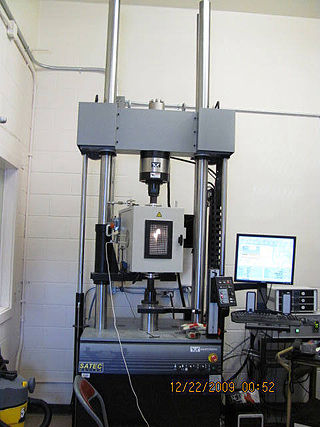
Building science is the science and technology-driven collection of knowledge in order to provide better indoor environmental quality (IEQ), energy-efficient built environments, and occupant comfort and satisfaction. Building physics, architectural science, and applied physics are terms used for the knowledge domain that overlaps with building science. In building science, the methods used in natural and hard sciences are widely applied, which may include controlled and quasi-experiments, randomized control, physical measurements, remote sensing, and simulations. On the other hand, methods from social and soft sciences, such as case study, interviews & focus group, observational method, surveys, and experience sampling, are also widely used in building science to understand occupant satisfaction, comfort, and experiences by acquiring qualitative data. One of the recent trends in building science is a combination of the two different methods. For instance, it is widely known that occupants' thermal sensation and comfort may vary depending on their sex, age, emotion, experiences, etc. even in the same indoor environment. Despite the advancement in data extraction and collection technology in building science, objective measurements alone can hardly represent occupants' state of mind such as comfort and preference. Therefore, researchers are trying to measure both physical contexts and understand human responses to figure out complex interrelationships.

The Lichfield Garrick is a modern, purpose-built theatre in Lichfield, a city in Staffordshire, England.

The Center for the Built Environment (CBE) is a research center at the University of California, Berkeley. CBE's mission is to improve the environmental quality and energy efficiency of buildings by providing timely, unbiased information on building technologies and design techniques. CBE's work is supported by a consortium of building industry leaders, including manufacturers, building owners, contractors, architects, engineers, utilities, and government agencies. The CBE also maintains an online newsletter of the center's latest activities called Centerline.
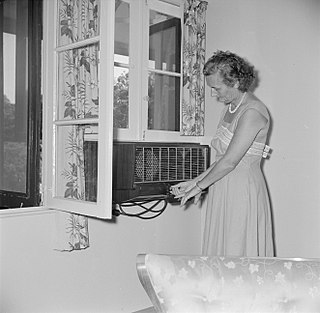
Air conditioning, often abbreviated as A/C (US) or air con (UK), is the process of removing heat from an enclosed space to achieve a more comfortable interior environment and in some cases also strictly controlling the humidity of internal air. Air conditioning can be achieved using a mechanical 'air conditioner' or alternatively a variety of other methods, including passive cooling and ventilative cooling. Air conditioning is a member of a family of systems and techniques that provide heating, ventilation, and air conditioning (HVAC). Heat pumps are similar in many ways to air conditioners, but use a reversing valve to allow them both to heat and to cool an enclosed space.
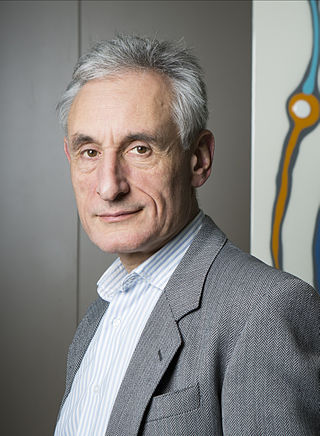
Andrew Blake FREng, FRS, is a British scientist, former laboratory director of Microsoft Research Cambridge and Microsoft Distinguished Scientist, former director of the Alan Turing Institute, Chair of the Samsung AI Centre in Cambridge, honorary professor at the University of Cambridge, Fellow of Clare Hall, Cambridge, and a leading researcher in computer vision.

Wolf Hartmut Hilbertz was a German-born futurist architect, inventor, and marine scientist. Notable contributions to science include the discovery of artificial mineral accretetion / biorock and its use to create electrified reefs.
Dean Hawkes is a British architect and award-winning academic. Born in 1938 he studied at Regional College of Art, Manchester and Clare College, University of Cambridge. His career combined practice, teaching and research:
Air changes per hour, abbreviated ACPH or ACH, or air change rate is the number of times that the total air volume in a room or space is completely removed and replaced in an hour. If the air in the space is either uniform or perfectly mixed, air changes per hour is a measure of how many times the air within a defined space is replaced each hour. Perfectly mixed air refers to a theoretical condition where supply air is instantly and uniformly mixed with the air already present in a space, so that conditions such as age of air and concentration of pollutants are spatially uniform.
David John Ibbetson is a British legal academic. He was Regius Professor of Civil Law at the University of Cambridge from 2000 to 2022, and President of Clare Hall from 2013 to 2020. From 2009 until 2012, he served as the chairman of the Faculty of Law, University of Cambridge. He was General Editor of the Cambridge Law Journal between 2003 and 2009.
Diana Ürge-Vorsatz is a Hungarian scientist. She is professor of Environmental Sciences at Central European University. She is the Director of the Center for Climate Change and Sustainable Energy Policy. She has published widely on environmental and energy studies, primarily climate change mitigation.
Richard John Eden was a British theoretical physicist who researched quantum field theory, nuclear theory and S-matrix theory in the 1950s and 1960s.

Michael Short is Professor of Control Engineering and Systems Informatics and leads the Centre for Sustainable Engineering at Teesside University in the UK. He received a BEng in 1999 and a PhD (Robotics) in 2003 from the University of Sunderland. In 2012 he was also awarded a PGCHE from Teesside University. He was previously at the University of Leicester until 2009, and was made Reader (Professor) in January 2015 and full (Chair) Professor in August 2020. Michael is also a time-served automation and process control engineer, with eight years' industrial experience.
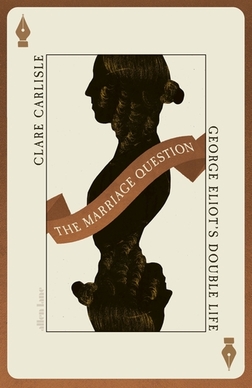
The Marriage Question: George Eliot's Double Life is a book written by Clare Carlisle and published by Allen Lane in 2023. The work explores the life and philosophy of Mary Anne Evans, known by her pen name George Eliot.
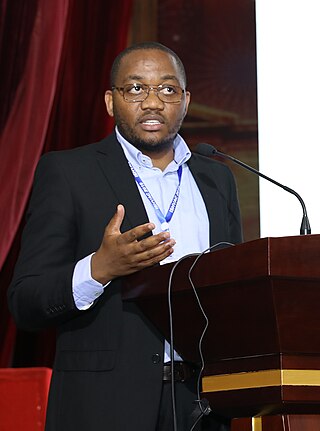
Alan Kabanshi is an engineer, researcher and associate professor of energy systems at the University of Gävle, Sweden. His work focuses on resource efficient systems in built environments, specializing in energy systems, sustainable building systems, Heating Ventilation and Air Conditioning (HVAC), and cognitive psychology of climate change. He is currently serving as a co-Director for the research programme Urban Transition under the profile Urban Sustainability.
References
- 1 2 "Short, Prof. (Charles) Alan, (born 23 March 1955), Professor of Architecture, University of Cambridge, since 2001 (Head, Department of Architecture, 2001–04); Fellow, Clare Hall, Cambridge, since 2002; Principal, Short & Associates, since 1997". Who's Who 2022 . Oxford University Press. 1 December 2021. doi:10.1093/ww/9780199540884.013.U43221 . Retrieved 13 August 2022.
- ↑ "Professor Alan Short". Clare Hall. University of Cambridge. Retrieved 13 August 2022.
- ↑ "Professor Alan Short MA Dip.Arch. Ph.D.(Cantab)". Department of Architecture. University of Cambridge. 28 March 2012. Retrieved 13 August 2022.
- ↑ Short, C. Alan (3 February 2018). "People in glass buildings shouldn't be allowed: these structures a". The Independent. Retrieved 13 August 2022.
- ↑ "The history man: Interview with Professor Alan Short". CIBSE Journal. Chartered Institution of Building Services Engineers. August 2017. Retrieved 13 August 2022.
- ↑ Hesson, Robert (24 March 2022). "Queens Building De Montfort University Leicester UK - Environmental Control". Northern Architecture. Retrieved 13 August 2022.
- ↑ "The Contact Theatre, Manchester". Civic Engineers. Retrieved 13 August 2022.
- ↑ Noon, Pat (September 2008). "The Lanchester Library — Building a Sustainable Library". LIBER Quarterly. 18 (2): 129–136. doi: 10.18352/lq.7916 . Retrieved 13 August 2022.
- ↑ "Naked Engineering - Natural Ventilation".
- ↑ "Lichfield Garrick Theatre". Theatre Tokens. Retrieved 13 August 2022.